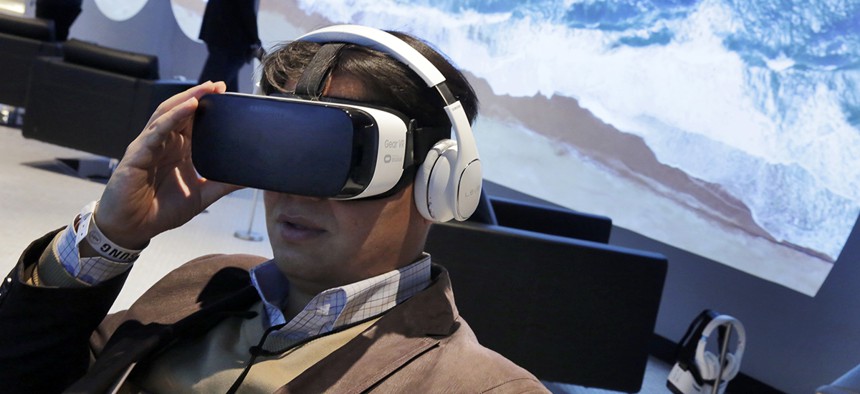Is Virtual Reality The Key To Government's Training Woes?

A user tests a Samsung Gear VR oculus. Richard Drew/AP File Photo
The head of a simulation trade group argues the technology could help agencies cut training costs.
Federal agencies could cut costs by training personnel virtually instead of in real life, the head of an Orlando-based tech trade group thinks.
The Defense Department already uses virtual reality for training purposes including flight simulations. But other government groups, including first responders, could use some of the same applications.
Nextgov spoke with Lt. Gen. Tom Baptiste, president of the National Center for Simulation, an advocacy group representing simulation-tech companies, about selling the federal government on the technology. This conversation has been edited for length and clarity.
NG: What are some of the coolest advances in simulated training systems today?
TB: You can simulate dropping weapons; you can fire missiles. You can take a pair of F-16 simulators at Shaw Air Force base in South Carolina and, virtually, you can link them into a real-world exercise, over the skies of Nellis Air Force Base [in Nevada]. Two pilots operating as a two-ship formation can be integrated into the tasking order of Nellis.
But the people in the simulator have the same threats, the same targets … The idea here is when the pilot goes to the simulator, they come out of there sweating and his heart beating fast, having really experienced a couple hours that isn’t absolutely like the real airplane, but it’s starting to get closer.
As computer processors got more powerful, so do the graphics and digital media and the visual displays. And there’s so much more you can do in a simulator. We’re starting to move toward suspending disbelief with the quality of the simulation. With suspending disbelief, it’s no longer just a carnival ride.
NG: What obstacles do your member companies face in selling this technology?
TB: When you’re actually in the airplane, and you’re under g-forces and all those things, a lot of those things you cannot replicate: the heat, the stress on the body, a lot of people talking in your ear. There’s a lot of things the simulation can get close to but will never fully replicate. You can’t experience that in a simulator.
» Get the best federal technology news and ideas delivered right to your inbox. Sign up here.
It still is a virtual rendition of the real thing. You’ve got to continue to move toward suspending disbelief. The biggest obstacle we have is convincing operators that this simulation is much more powerful and can replace some of that live training. In the current budget environment, you’ve still got to produce a combat ready soldier, sailor, airman, Marine. Virtual becomes a much bigger part of the training.
NG: So, what’s your sales pitch to the government, outside of the military?
TB: It’s a cost-effective alternative to live training. In the current budget environment, operational command has no choice but to find a way to do things differently, which means a different mix of live training and virtual training. [In research and development], if you can find a way to model and use simulation for testing and evaluation, you can reduce some of those costs, those false starts and errors.
NG: What’s the difference between virtual reality and simulation?
TB: Virtual reality is just one tool. In the Dismounted Soldier Training System, which is a core Army program, the idea was to immerse a single soldier or a group of soldiers into a virtual environment that replicated an Afghan city or an Iraqi city … So you don’t need a 10,000-acre range and live weapons; you can do it in a virtual world. It’s a new approach to developing -- not a device-based type of simulation -- but a virtual world that can be an immersive environment that you can replicate anywhere.
NG: Who do you think will be the next big adopters of simulation-based training?
TB: There’s a lot of synergy and lots of lessons learned from the experience of the Department of Defense that can be applied directly to first responders and Homeland Security. If you look at Homeland Security or FEMA, the way you train first responders is no different than training combat medics.
NG: Aren’t simulators cost-prohibitive for first responders at the local level?
TB: We need to think creatively. For most municipalities, and in some cases counties, to fully embrace the power of simulation, it might be out of reach. So, you might need to think regionally about establishing training centers that can be leveraged and used by many different municipalities.


